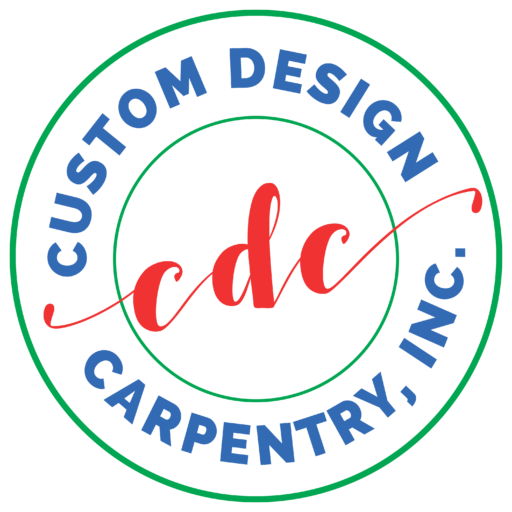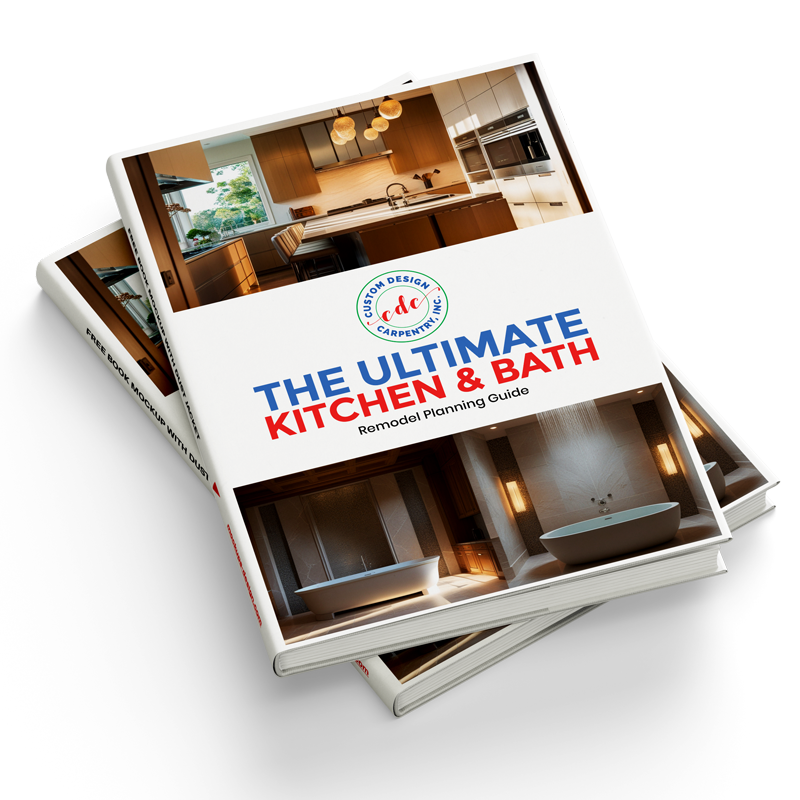By Custom Design Carpentry– Renovation & Remodelling
When remodeling your kitchen, every design choice matters but few are more important than the materials you select. From countertops and cabinets to flooring and backsplashes, the materials you choose influence not only how your kitchen looks, but also how it performs over time. A beautiful kitchen loses its charm quickly if surfaces stain easily, scratch with minimal use, or fail to hold up under heavy foot traffic.
The right materials will complement your design style, match your lifestyle needs, and stay within your budget. In this guide, we’ll walk through the essential materials used in kitchen remodeling, helping you understand their pros, cons, and how to make smart selections for a space that is both stunning and durable.

Start with the Countertops: Form Meets Function
Countertops are among the most frequently used surfaces in any kitchen. They must withstand daily food prep, resist spills, and maintain their appearance under heat, moisture, and wear. There’s no one-size-fits-all solution, so it’s important to match the material to your cooking habits, maintenance preferences, and design goals.
Quartz has surged in popularity due to its durability, non-porous surface, and wide range of color options. Unlike natural stone, quartz doesn’t require sealing and is highly resistant to stains and scratches. It’s a great option for busy households that want a modern, low-maintenance look.
Granite offers a more natural, high-end appearance with unique veining and patterns in each slab. While it’s durable and heat-resistant, it does require periodic sealing to prevent staining. Those who prefer a more organic, natural element in their kitchen may lean toward granite for its one-of-a-kind appearance.
Butcher block provides warmth and texture that’s hard to match. It’s excellent for casual or rustic kitchens and serves well in prep areas. However, it’s prone to scratches, needs regular sealing, and can harbor bacteria if not properly maintained. Homeowners who want a tactile, farmhouse-style kitchen often integrate the butcher block with other surfaces for visual interest.
Other popular options include marble, which offers unmatched elegance but is softer and more porous than other materials, and laminate, a budget-friendly choice with improved durability and style compared to its past reputation.
Cabinets: Balancing Style and Storage
Cabinets are one of the most visually dominant features in any kitchen. They play a huge role in the room’s style while also providing vital storage. Material choices here affect not only the look but also the longevity and cost of your remodel.
Solid wood remains a classic choice for cabinet construction. Options like maple, oak, and cherry are strong, versatile, and easy to paint or stain. They tend to be more expensive, but their lifespan and timeless appeal often make them worth the investment. Plywood is another durable material commonly used for cabinet boxes, offering stability and resistance to moisture over time.
For those seeking a more budget-conscious route, medium-density fiberboard (MDF) is a popular alternative. MDF has a smooth surface perfect for painted finishes and is resistant to cracking or peeling, though it’s less durable when exposed to water. Thermofoil cabinets, which involve a vinyl coating applied to MDF or particleboard, provide a sleek, modern look and are very low maintenance. However, they are more vulnerable to heat damage.
The style of the cabinet doors whether shaker, flat-panel, or inset—also determines the overall feel of the kitchen. In modern renovations, many homeowners mix materials, such as combining painted upper cabinets with woodgrain lowers, to add texture and dimension.
Flooring: Durability Underfoot
Kitchen floors take a daily beating from foot traffic, spills, and dropped utensils, so durability and water resistance are key. At the same time, your flooring needs to tie the space together aesthetically.
Luxury vinyl plank (LVP) has become a favorite in kitchen remodels due to its water resistance, affordability, and visual appeal. It mimics the look of hardwood or stone while offering a softer, quieter surface that’s easier on the feet. LVP is an excellent choice for families or homes where comfort and practicality are priorities.
Porcelain and ceramic tile remain go-to options for kitchens. These materials are highly durable, resistant to water, and available in a wide variety of styles and finishes. Textured tiles can reduce slipperiness, and radiant heating can be installed underneath for added comfort during colder months.
Hardwood floors bring timeless warmth and elegance to a kitchen, especially when extended from adjacent living areas. Engineered hardwood, which has a hardwood veneer over a plywood core, is a more moisture-resistant alternative to solid wood and is better suited for kitchen environments.
Cork and bamboo are also worth considering for eco-conscious homeowners. Cork is naturally anti-microbial and soft underfoot, while bamboo offers a sustainable hardwood alternative with a distinctive look.
Backsplashes: Function and Personality
Backsplashes serve both a practical and decorative purpose. They protect your walls from splashes and stains while providing an opportunity to infuse personality into your kitchen design.
Subway tiles continue to be a staple for their clean, timeless appeal. Available in ceramic, glass, and natural stone, they can be arranged in creative patterns like herringbone or stacked layouts to add modern flair.
Glass tiles offer vibrant colors and a reflective finish that brightens up the kitchen. They’re easy to clean but can be more expensive to install due to the need for precise handling.
Natural stone like marble or travertine brings an organic, luxurious touch to the kitchen but may require more maintenance due to its porous surface. For homeowners who prefer minimalism, large-format slabs that match the countertop material are increasingly popular for creating a seamless, modern look with fewer grout lines.
Peel-and-stick options also exist for quick updates on a budget, although they’re best for temporary solutions or rental properties.
Hardware, Fixtures, and Finishing Touches
Though small in size, hardware and fixtures play a big role in tying your material choices together. Cabinet handles, sink faucets, and lighting fixtures come in a range of finishes—from brushed nickel and matte black to brass and copper. These elements should complement your chosen materials and add the finishing polish to your kitchen.
Fixtures should be both stylish and functional. Pull-down faucets with flexible sprayers, deep sinks made from fireclay or stainless steel, and under-cabinet lighting all contribute to a kitchen that’s both beautiful and a joy to use daily.

FAQs About Kitchen Remodel Materials
Q1: What is the most durable countertop material for a kitchen?
Quartz is considered one of the most durable options due to its non-porous surface, resistance to scratches and stains, and lack of required maintenance. Granite is also durable but needs periodic sealing.
Q2: Are hardwood floors a good choice for kitchens?
Yes, but with some caveats. While hardwood floors offer a timeless look and can be refinished, they are more susceptible to moisture. Engineered hardwood is a more kitchen-friendly alternative due to its better resistance to humidity.
Q3: What cabinet material is best for humid climates or heavy kitchen use?
Plywood and solid hardwood are excellent choices for durability and moisture resistance. Thermofoil and MDF can work well in dry environments but may not hold up as long under constant exposure to steam or water.
Q4: How do I choose a backsplash that won’t go out of style?
Neutral tones and classic shapes, such as white subway tiles, tend to stay in style over time. To add personality without long-term commitment, you can introduce color or pattern through accessories and switch them out as trends change.
Final Thoughts
Choosing the right materials for your kitchen remodel is one of the most important parts of the renovation process. Every surface—from your countertops to your flooring, must balance beauty, function, durability, and budget. The materials you select will shape how your kitchen performs, how it looks, and how well it holds up to your lifestyle.
At Custom Design Carpentry Inc., we help homeowners navigate every material decision with clarity and confidence. Whether you’re aiming for a high-end contemporary kitchen or a warm, classic space, our design-build team ensures each selection is aligned with your goals and needs.
Ready to start planning your dream kitchen? Contact us today for a consultation and let’s create a space you’ll love for years to come.
Author’s website- Custom Design Carpentry
Phone- (973) 980 608


